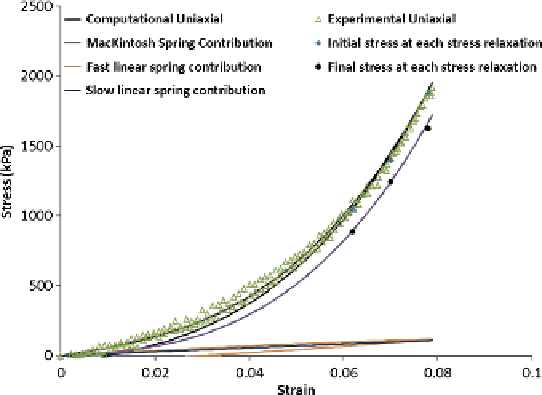Biomedical Engineering Reference
In-Depth Information
Fig. 25.5
Obtaining parameter constants from the instantaneous load-unload response (
triangles
)
and the equilibrium response from the stress relaxation data (
circles
)
25.3.2 Determination of the Model Parameters
Stress and strain data from the uniaxial test and the final value of the stresses from
each stress relaxation test conducted on the same specimen are used to determine
the range of the model parameters. As shown in Fig.
25.5
, first, the parameters of the
MacKintosh 8-chain model,
L
c
,
l
p
, and
nkΘ
, are determined by fitting the three final
stress points shown in black dots to a nonlinear elastic MacKintosh model shown
by the solid purple line in the figure. With these three parameters determined, the
contributions of the two linear springs (yellow and blue curves) are added to the
model to fit the uniaxial test data. The rate of the uniaxial test is 0.05 s
−
1
, therefore,
one load-unload test ends within 4 seconds. The hysteresis of the uniaxial load-
unload response can be fit using the viscosity of a fast linear dashpot. Finally, using
the three sets of stress relaxation data, the parameters associated with the linear
series spring-dashpot systems are adjusted so that the same set of seven parameters
can fit all three stress relaxation response curves as well as the uniaxial tension
response obtained from the same specimen.
A rate formulation is employed to compute the stress vs. strain responses of var-
ious tissues to a cyclic load/unload test. Time and the total stretch are prescribed so
that
F
v
can be explicitly computed based on updating the rate of deformation of the
viscous dashpots from the previous time step.
F
e
is, therefore, updated in the current
time step using
F
e
FF
v
−
1
and then used to compute the stresses. Once the total
stress is calculated the deformation increments of the dashpots are updated based on
the stress in each dashpot element and the next increment of viscous deformation,
the
F
v
=
for each dashpot, is determined for the next time step.

